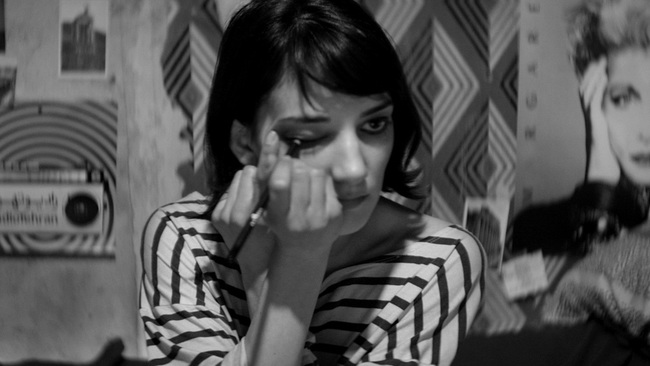Review: A Girl Walks Home Alone At Night
Directed by Ana Lily Amirpour • 2014 • 99 min • in Farsi with English subtitles
Set in a fictional Iranian city, shot in California, and featuring a budding romance between a modern-day James Dean and a vampire, A Girl Walks Home Alone At Night is fresh and clever mash-up of genres and cultures. In her director’s statement, Ana Lily Amirpour points to the film’s indebtedness to Sergio Leone, David Lynch, Nosferatu, Die Antwoord, and more. An eclectic mix, no doubt, these give a sense of the film’s surprisingly compatible range of referents.
Arash (Arash Marandi) lives in Bad City, looking after his burdensome father Hossein (Marshall Manesh). The proud owner of a flashy, classic sports car, Arash has to work long hours at a five-star hotel to afford his image of wealth. His hopeful ambitions and lower-class lifestyle are at odds and in sharp focus at the outset. When his prized vehicle is taken in lieu of payment for Hossein’s drug habit, Arash looks to settle things with the slimy local pimp/drug dealer Saeed (Dominic Rains). Meanwhile, Saeed has incurred the wrath of the titular Girl (Sheila Vand) over his abusive behaviour towards Atti (Mozhan Marnò), a sex worker reluctantly working under his authority.
In an amusingly gory twist, we find that the Girl, lured to Saeed’s apartment when he finds her on the street after dark, is in fact a vampire waiting to strike. Silently following him and patiently letting him show off in an embarrassing display of machismo, she quickly and shockingly emasculates and kills him. With Arash’s problems suddenly solved, he develops an interest in the town’s new and intriguing stranger while she continues to prey on Bad City’s far from innocent men.
It is only fitting that a vampire film feel as timeless as A Girl Walks Home Alone At Night does, blending 1950s cool with contemporary drug culture to evoke the permanence of the afterlife. But Girl also points to specific periods through the Girl’s apartment, the decor and musical choices aesthetically tied to the 70s and 80s disco and punk scenes.
Such referents are difficult to resist as potential sites of interpretation, from the Iranian New Wave, to the cultural clashes of the Iranian Revolution, to the more benign retro chic of contemporary hipsterdom. All of these blend and clash in what is, on the whole, a vampire western set on an indefinable frontier. While the characters speak Farsi in what appears to be Iran, the film is very much an American co-production, with an international cast recognizable from Ben Affleck’s Argo, How I Met Your Mother, and House of Cards among others.
Similarly, the Girl’s Hijab is at once a straightforward religious marker, a witty stand-in for Dracula’s cape, and a source of questions surrounding gender. The Girl represents a threat, though one that subverts that evoked by the film’s title. Her Hijab very directly ties her to her femininity, to her religion, and - particularly in an Iranian/American film - to the rather heavy cultural and political baggage of post-9/11 America.
The Girl is simultaneously vulnerable and threatening, representing fears of and for the lone woman even while she punishes the town’s patriarchs - her victims are invariably men, and she seems highly protective of Atti, especially during moments of exploitation and male oppression. The many scenes in which she stalks her prey are curious, shocking, and ultimately highly satisfying.
The playful collage of symbolism sometimes obscures Girl’s meaning, but much of the fun, as a viewer, is sussing out Amirpour’s message, and occasional lack thereof. The two main characters exchange very few words. What little is spoken between them tends towards the cryptic, and we are left primarily with evocative sounds and images, hints of political and social commentary as well as pop cultural indulgence. The film is so rich in potential meanings, and yet it seems to constantly flirt with a kind of nihilistic fun. It is destabilizing in the very best way.
Playing on the film’s mythical qualities and highly visual storytelling, Amirpour is releasing a series of prequel graphic novels telling the Girl’s history. The first of these, Death Is the Answer, was released in conjunction with the film and is now available.
